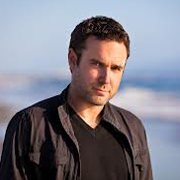It opens as just another day for Dr. Gabriel Stanton. He's a specialist, a researcher who studies incurable prion diseases for the CDC. Most people would never guess it while he is taking in his morning bike ride along the California coastline.
What makes prion diseases frightening is that they cause progressive neurodegenerative disorders as rogue forms of protein build up in the brain. They are also relatively rare and scientists are baffled by them. Isolated but sporadic cases appear out of nowhere every year.
The prion disease Stanton encounters is different.
What makes this one different is that it acts fast, causes fatal insomnia, and can be passed on by casual contact. This makes discovering the source of the infection especially important because whatever the Mayan who acquired it ate might still be on the market. If it is like mad cow disease, the plant will have to be shut down, food pulled from the shelves, and school lunches scrapped.
Worse, patient zero is not a native. He just recently arrived in Los Angeles to sell a few Mayan artifacts that he looted from a lost city somewhere in South America. One of those artifacts, an ancient codex, ends up in the hands of Chel Manu, a researcher and curator at the Getty Museum.
She didn't purchase the codex and isn't comfortable having it. She was simply asked to hold it for safe keeping. The owner, Hector Gutierrez, makes his living by selling smuggled antiquities on the Internet.
Manu's first reaction is tell Gutierrez that the risk is too great. He tempts her, however, by showing her what could be one of the greatest finds of the century. She knows all too well that if she refuses, then the codex would be seized, returned, and likely locked away without the benefit of proper preservation.
The suspense rushes ahead as the CDC looks to isolate the disease.
With the looming December 21 deadline days away, it's only natural for some people to make a connection between these events and the Mayan calendar. One in ten people already expect some cataclysmic event. The discovery of a codex and an aggressive prion disease is all the push they need.
What makes this book better than most Mayan-themed stories is that the author doesn't fall headfirst into mythos. He keeps his skepticism intact, with his characters considering that it's coincidence. And while that may be, it still won't stop the government from considering a quarantine of greater Los Angeles.
A suspenseful pandemic accurately describes the first part of the book, but not all of it. Once the scientists settle into a finding a cure and the researchers aim to decipher the codex in the hope of discovering where it came from, the pace slows considerably with a translation of the codex.
This rare first person account of a Mayan scribe is interesting, but nowhere near the level of suspense generated without it. Mostly, the codex describes the pressures of a monstrous drought and an ambitious king driven by conquest. Within this context, the story becomes an historical insert into the thriller.
Later, it changes again. When Stanton and Manu devise a plan to break the quarantine and set out in search of the lost city, any sense of a thriller is forgotten. Instead, it becomes more adventurous in the vein of modern-day archeologist-heroes without the benefit of a whip or fedora.
Two graphs about author Dustin Thomason.
 Dustin Thomason brings his background in anthropology and medicine to bear in a convincing and somewhat grounded story that capitalizes on the Mayan calendar. There isn't much question that the Harvard graduate who won the Hoopes Prize for undergraduate writing is ever-present and his studies as a M.D. pays off in making the medicine as plausible as the archeology.
Dustin Thomason brings his background in anthropology and medicine to bear in a convincing and somewhat grounded story that capitalizes on the Mayan calendar. There isn't much question that the Harvard graduate who won the Hoopes Prize for undergraduate writing is ever-present and his studies as a M.D. pays off in making the medicine as plausible as the archeology.After co-writing his first book, the Rule Of Four, with long-time friend Ian Caldwell, Thomason went on to create and produce a number of television series with Fox and ABC. 12:21: A Novel is his solo debut and he gets most of it right. The medical crisis is suspenseful. The Mayan story is plausible. The adventure at the end is interesting if not cliche.
12:21: A Novel Entombs 3.7 On The Liquid Hip Richter Scale.
12:21 is a fine novel even though it reads like three stories, woven together by the conveniently connected plot line. But this also makes the incongruities stand out much more than needed, and has caused more than one reader to tune out in the middle. For those interested in archeology, pandemics, and Mayan culture, Thomason provides a well-research glimpse of all three along with a much more grounded take on the myth of December 21. Worth the read.
12.21: A Novel is available on Amazon. You can also download it for iBooks or the audiobook from iTunes. The audiobook is read by Fred Sanders and Noel Rodriguez, giving the story a distinction between the present and the past. Dustin Thomason also contributes a short afterward. In addition to the English novel, Barnes & Noble also carries the Spanish version.
![Liquid [Hip]](https://blogger.googleusercontent.com/img/b/R29vZ2xl/AVvXsEjAFBQPqS7J0-rrttNoRYSsuwIePPZf4Nq6sqDioK1zzVQXJIQXKzq_NVNI4n6h3inuRQFBKOcJeZeSufkdHHIOxbSWyBjTjTxgKEQGyPzdwvkEEeECh4bI5YEGk4RWGUINSd7vulPQsCA/s1600-r/liquidhip.jpg)

